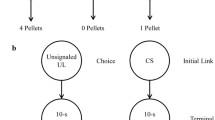Abstract
Despite the prevalence of problem gamblers and the ethical issues involved in studying gambling behavior with humans, few animal models of gambling have been developed. When designing an animal model it is necessary to determine if behavior in the paradigm is similar to human gambling. In human studies, response latencies following winning trials and near win trials are greater than those following clear losses. Weatherly and Derenne (Anal Gambl Behav 1:79–89, 2007) investigated whether this pattern was found with rats working in an animal analogue of slot machine gambling. They found a similar pattern of response latencies but the subjects’ behavior did not come under control of the visual stimuli signalling the different outcomes. The animal model of slot machine gambling we used addressed procedural issues in Weatherly and Derenne’s model and examined whether reinforcer magnitude and the presence of near win trials influenced response latency and resistance to extinction. Response latencies of the six female Norway Hooded rats varied as a function of reinforcer magnitude and the presence of near-win trials. These results are consistent with prior research and with the idea that near win trials serve as conditional reinforcers.




Similar content being viewed by others
References
Abbott, M. W. (2001). Problem and non-problem gamblers in New Zealand: A report on phase two of the 1999 national prevalence survey. Report number six of the New Zealand gaming survey. Wellington: Department of Internal Affairs.
Abbott, M. W., Volberg, R. A., & Rönnberg, S. (2004). Comparing the New Zealand and Swedish national surveys of gambling and problem gambling. Journal of Gambling Studies, 2, 237–258.
Cote, D., Caron, A., Aubert, J., Desrochers, V., & Ladouceur, R. (2003). Near wins prolong gambling on a video lottery terminal. Journal of Gambling Studies, 19(4), 433–438.
Delfabbro, P. H., & Winefield, A. H. (1999). Poker machine gambling: An analysis of within session characteristics. British Journal of Psychology, 90, 425–439.
Dixon, M. R., & Schreiber, J. B. (2002) Utilizing a computerized video poker simulation for the collection of data on gambling behavior. The Psychological Record, 52, 417–428.
Dixon, M. R., & Schreiber, J. E. (2004). Near-miss effects on response latencies and win estimations of slot machine players. The Psychological Record, 54, 335–348.
Giroux, I., & Ladouceur, R. (2006). The effect of near wins on the choice of a video lottery terminal. Gambling Research, 18, 69–75.
Griffiths, M. D. (1999). The psychology of the near miss (revisited): A comment of Delfabbro and Winefield. British Journal of Psychology, 90, 441–445.
Griffiths, M. D., & Wood, R. (2001). The psychology of lottery gambling. International Gambling Studies, 1, 27–45.
Kassinove, J. I., & Schare, M. L. (2001). Effects of the ‘near miss’ and the ‘big win’ on persistence at slot machine gambling. Psychology of Addictive Behaviors, 15, 155–158.
Ladouceur, R., & Sevigny, S. (2002). Symbols presentation modality as a determinant of gambling behavior. The Journal of Psychology, 136, 443–448.
MacLin, O., Dixon, M. R., Dougherty, D., & Small, S. (2007). Using a computer simulation of three slot machines to investigate a gambler’s preference among varying densities of near-miss alternatives. Behavior Research Methods, 39, 237–241.
Madden, G. J., Ewan, E. E., & Lagorio, C. H. (2007). Toward an animal model of gambling: Delay discounting and the allure of unpredictable outcomes. Journal of Gambling Studies, 23, 63–83.
Reid, R. L. (1986) The psychology of the near miss. Journal of Gambling Behavior, 2, 32–39.
Schreiber, J., & Dixon, M. R. (2001). Temporal characteristics of slot machine play in recreational gamblers. Psychological Reports, 89, 67–72.
Skinner, B. F. (1953). Science and human behaviour. New York: Free Press.
Strickland, L. H., & Grote, F. W. (1967). Temporal presentation of winning symbols and slot machine playing. Journal of Experimental Psychology, 74, 10–13.
Weatherly, J. N., & Derenne, A. (2007). Rats playing a slot machine: A preliminary attempt at an animal gambling model. Analysis of Gambling Behavior, 1, 79–89.
Wohl, M. J. A., & Enzle, M. E. (2003). The effects of near wins and near losses on self-perceived personal luck and subsequent gambling behavior. Journal of Experimental Social Psychology, 39, 184–191.
Acknowledgements
The authors wish to acknowledge the Science Faculty of Victoria University of Wellington and the Open Polytechnic for grants that supported this research and Kevin Grieg’s able assistance in collecting the data.
Author information
Authors and Affiliations
Corresponding author
Rights and permissions
About this article
Cite this article
Peters, H., Hunt, M. & Harper, D. An Animal Model of Slot Machine Gambling: The Effect of Structural Characteristics on Response Latency and Persistence. J Gambl Stud 26, 521–531 (2010). https://doi.org/10.1007/s10899-010-9183-3
Published:
Issue Date:
DOI: https://doi.org/10.1007/s10899-010-9183-3




